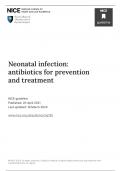Summary
Summary neonatal_infection_antibiotics_for_prevention_and_treatment
- Course
- Institution
Neonatal infection: antibiotics for prevention and treatment NICE guideline Published: 20 April 2021 Last updated: 19 March 2024 © NICE 2024. All rights reserved. Subject to Notice of rights ( notice-of-rights). Your responsibility The recommendations in this guideline represent the view of...
[Show more]



